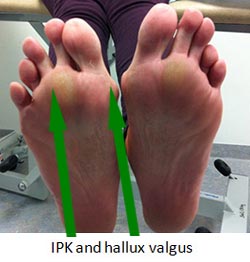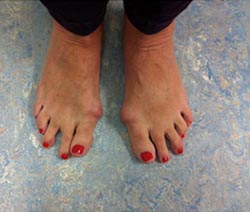What is Metatarsalgia?
Metatarsalgia is a symptom rather than a diagnosis and literally means pain in the metatarsal (which is the bone in the foot at the base of the toes). The term tends to be most commonly used to refer to pain in the ball of the foot in the region of the lesser metatarsal i.e. not the first (big toe) metatarsal.
 Why does it develop?
Why does it develop?
There are a number of reasons why one can develop pain in the region of the metatarsal, a number of them are listed below. They usually occur because the lesser metatarsals are being overloaded due to either abnormal foot posture (such as the presence of hallux valgus in which the big toe is thought not to function appropriately), tight calf muscles or excessive load (eg. Weight, excessive exercise etc.)
a. Problems with the nerves:
eg. Morton’s neuroma: problem with the nerve that runs between the metatarsals (see: Morton’s Neuroma.)
b. Problems with the joints
eg. Metatarsophalangeal joint synovitis: inflammation of the joint at the base of the toe.

View if the same feet from above.
c. Problems with the bones
eg. Intractable plantar keratosis (IPK): thickening of the skin under the metatarsal head. (see photo).
Stress fracture: this is a fracture of the metatarsal which occurs because the bone is being subjected to repeated stress that it can only just tolerate and if the stress occurs too frequently the bone eventually breaks.
Billy Jowett
d. Problems with the toes
eg. Hammer/ Claw toes: abnormal posture of the toes can lead to pressure on the metatarsal on the sole of the foot. (See: Hammer Toe Correction).
What symptoms does it cause?
As mentioned above metatarsalgia is a term used to describe pain in the metatarsal region of the foot. The type of pain and its initiating and relieving factors will depend on the cause of the pain (see above)
What options are there for treatment?
The options available for treatment will depend on the cause of the problem (see links above, if no link is available your specialist will be able to discuss the treatment options with you.)
